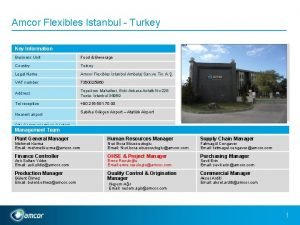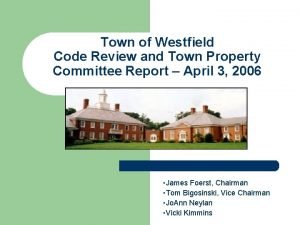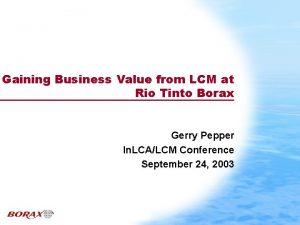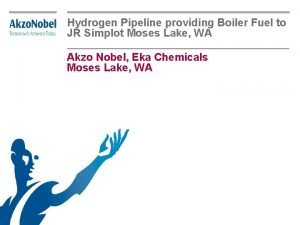Australian Paper Amcor Rio Tinto Simplot Wesfarmers Westfield


















- Slides: 18

Australian Paper, Amcor, Rio Tinto, Simplot, Wesfarmers, Westfield, Woolworths (Rule Change Committee) Briefing to AEMC Forum 23 November 2011 The Chifley, Brisbane

Contents Introduction to the Committee 2 Statement of the problem Elements of a solution The Committee’s proposals

About the Committee • Consists of representatives from Australian Paper, Amcor, Rio Tinto, Simplot, Wesfarmers, Westfield, Woolworths. Committee members are also members of the Energy Users Association of Australia. • Formally constituted in April 2011, after six months of preparation. • Chairman elected by Committee. All major decisions by consensus. • Committee members have fully funded and governed this rule change proposal • Committee is motivated to make a constructive contribution to Australia’s energy regulator frameworks and guided by the pursuit of the National Electricity Objective (long term interest of (all) consumers) 3

What is the problem ? 1. The regulatory allowance for the return on debt for regulated network service providers in the NEM is significantly higher than the cost of debt, particularly for those NSPs owned by state governments. 2. This has resulted in: – excessive profits for network service providers at the expense of higher prices for energy users; – incentives to over-invest in order to expand the asset base and maximise profits. 3. The reason for this outcome is, primarily, flawed Rules. 4

Evidence of the difference between the cost of debt and allowed return on debt (privately owned NSPs) (1) AER determination of allowed return on debt for NEM distributors 10, 00% Regulated return on debt for distributors in NZ and GB 9, 00% Yield to maturity (at issue) for 5 year bonds issued by members of our committee Nominal cost of debt (%) 8, 00% 7, 00% 6, 00% 5, 00% 4, 00% 3, 00% 2, 00% 1, 00% N Z ry ea su Tr es t SW N tr al A us W ia n ib is tr (d em fie ld r pe Pa or ut rm fa es W C om O m fg er s) s er A us ne ce C SP is s m om ER A t n io ) (N po iti A ER (C ld (Q A ER SW w SA an d en em (J ER A er ) ) a) 0, 00% 5 Actual of cost of debt for private and government distributors Source: Regulatory decisions, term sheets, CME analysis

Evidence of the difference between the cost of debt and allowed return on debt (privately owned NSPs) (2) Source: ASX announcements, CME analysis Data on recently issued bonds suggests 191 basis point difference between yield to maturity at issue, and AER allowed return on debt. Furthermore the evidence of issued bonds and bank debt by SPI, DUET and Spark Infrastructure in 2008 and 2009 does not support the claim that debt costs for regulated utilities were materially higher during the GFC. 6

Evidence of the difference between the cost of debt and allowed return on debt (privately owned NSPs) (3) Five-yearly rolling average yield to maturity of 5 year corporate bonds issued in Australia Source: CEPA By comparison, AER has allowed ~ 9% return on debt. 7

Evidence of the difference between the cost of debt and allowed return on debt (government-owned NSPs) Actual cost of debt clearly substantially below the circa 9% allowed return on debt Source: CEPA 8

This has translated into windfalls for shareholders and higher prices for consumers … Excessive allowed return on debt has translated in to network prices around 12% higher than they would be if based on the cost of debt 9

… and incentives for inefficient over-investment Margins on debt, particularly for government-owned NSPs, has encouraged more capital spending than necessary 10

And, the main reason for this is an inappropriate Rule • The AER has discretion to set benchmark credit rating and term (during each price review for distribution and in the Statement of Regulatory Intent for transmission). Some improvement may be made through an appropriate choice of these parameters (and this does not require a Rule change). • But, the Rules bind the AER to a specific and inappropriate calculation of both the risk free rate and the debt risk premium. And the Rule fails to adequately take account of actual debt costs. Changes to the Rule is needed to rectify this. 11

Elements of a solution • Scope of comparators (just network businesses, or some or all other corporates, Australia only or international as well ? ) • Maturity (5 or 10 year bonds – or longer or shorter ? ) • Averaging period (over what period of time is the yield to maturity to be assessed ? ) • Credit rating of debt (A, BBB, both, one, something specific ? ) • Treatment of embedded debt (should the chosen rate reflect estimates only of forward debt costs or also take account of historic costs? ) • Accounting for differences in funding and profit flows between privately-owned and government-owned businesses (governmentowned NSPs have access to Treasury bonds, and state governments receive profits and taxes from their NSPs) 12

Some comments on specific aspects (1) • • 13 Scope of comparators: – ideally electricity networks / regulated utilities only. But dataset too small to forced to look more widely; – Australia only (challenges in translation of international markets back to Australia can be problematic). Maturity: – 5 years is now the commonly accepted measure by Australian regulators. – More than 2/3 rds of network utility debt is payable in less than 5 years. Averaging period: – Debt markets can be volatile, use of a reasonable averaging period will deliver a more stable result; – Allowed returns closer to the way that NSPs fund themselves reduces financeability risks Credit rating: – A broader range of credit ratings extends the data available and so reduces implementation problems; – A high level of specificity (e. g. BBB+) seems unjustified when taking account of actual NSP bond ratings

Some comments on specific aspects: government ownership Is the existing discriminatory arrangement in favour of government-owned NSP’s justifiable? – Competition Principles Agreement does not support treatment of governmentowned NSPs as if they are privately owned. But tax payers should be compensated for NSP default risks that they are bearing. – Finding the balance requires a wider examination of the profitability of NSPs to their government owners. Pecuniary benefits to the NSW Government from its electricity distributors and retailers in 2010 NSW Government is receiving a Return on Equity of 28. 3% compared to AER’s intended regulatory determination of ~ 10. 3 %. 14 Allowing a margin on actual cost of borrowing for government-owned NSPs can not be justified against the National Electricity Objective

The Committee’s proposals Government-owned NSPs: Return on Debt for each year of the regulatory control period to be based on the average daily yield to maturity in the previous calendar year of all bonds issued by the relevant government (that owns the NSP) that have between 3 and 7 years to maturity. Privately-owned NSPs: Return on debt for each year of the regulatory control period to be established based on an equal weighting of the average yield to maturity for the five years to the end of the last calendar year, of all broad BBB and A rated corporate debt issued in Australia. 15

Implications of the Committee’s proposals If (hypothetically) applied to all NSPs in 2011, this would result in a reduction of regulated revenues of around 11. 5% and a reduction in retail prices of around 6. 3%. But the Committee is not proposing to re-open existing decisions. 16

Our proposals on the return on debt differ from the AER’s • Valuable for rules on the allowed return on debt to be established, rather than to leave it to regulatory review: – Essential to have a comprehensive review of the issues against the NEO criterion and to involve all interested parties in an issue with a high level of policy content; – Greater investment and price certainty; – Transparent action to address regulatory concerns. 17

Contact Details Policy & General Enquiries Technical / Economic Enquiries Brian Green Australian Paper Bruce Mountain Carbon Market Economics Chairman Network Rule Change Committee Project Manager / Technical Director Network Rule Change Committee Tel 03 8540 2384 Tel 03 9664 0680 Mob 0407 804 490 Mob 0405 505 060 brian. green@australianpaper. com. au bruce. mountain@carbonmarkets. com. au 18
 Agrupamento de escolas de rio tinto
Agrupamento de escolas de rio tinto Rio tinto srbija
Rio tinto srbija Objectives of organisational culture
Objectives of organisational culture Wesfarmers cef
Wesfarmers cef Sumerios
Sumerios Rio hondo look up classes
Rio hondo look up classes Fatmagül cengaver
Fatmagül cengaver Pandora westfield stratford
Pandora westfield stratford Scaphiod fracture
Scaphiod fracture Westfield sports injuries
Westfield sports injuries Westfield
Westfield Parenzo invest
Parenzo invest Westfield referral code
Westfield referral code Westfield stratford footfall
Westfield stratford footfall Dmv westfield nj
Dmv westfield nj Westfield state curca
Westfield state curca English general paper paper 2 comprehension
English general paper paper 2 comprehension Aice general paper 1
Aice general paper 1 Australian curriculum ict
Australian curriculum ict
































